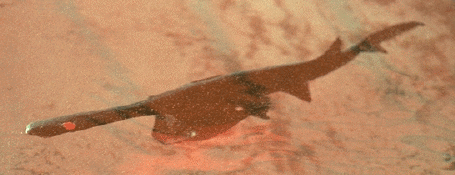Introduction to the Chondrostei

Two chondrostean lineages survive today: the sturgeons of Eurasia and North
America, and the paddlefish (shown here) of
North America and China. These two lineages have secondarily lost
a number of actinopterygian traits: they lack
scales on most of the body, have a cartilaginous skeleton,
and have developed a shark-like, heterocercal tail and a rostrum
extending past the mouth (and forming the long "paddle" of the paddlefish
shown here). The lineage is thought to be quite ancient,
but the fossil record of chondrosteans themselves is quite poor, since the
skeleton is cartilage instead of bone. However, some bony relatives of the
living chondrosteans, known as saurichthyids or "lizard fish,"
lived in the Triassic and early
Jurassic.
Unfortunately, these odd and ancient fish
are currently endangered, because of habitat degradation and, in the
case of several sturgeon species, overfishing for their flesh and
their eggs (caviar).
Visit the
Sturgeon of
the Hudson River Homepage for ecological and conservation information about sturgeon populations.







